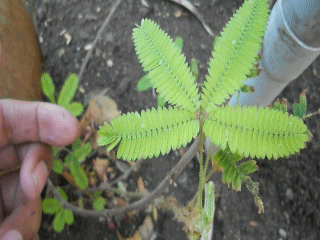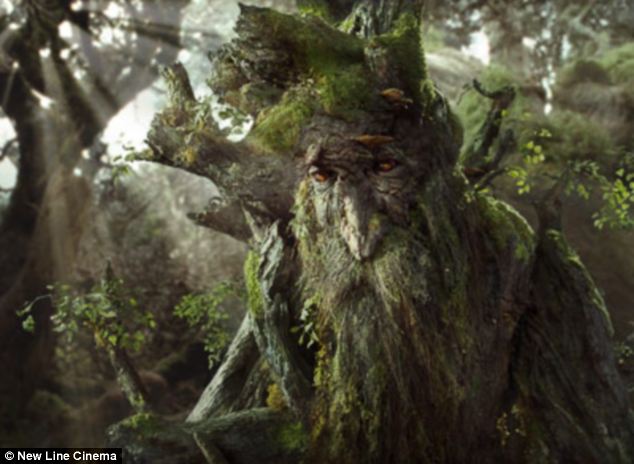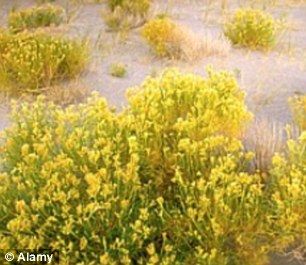
- Scientists from the University of Western Australia found Mimosa pudica plants can learn and remember as well as some animals
- Fern responds to touch and curls up to protect itself from predators
- But eventually 'learned' not to curl up when rain drops landed on it
- Researchers aren't certain why the plants are able to do so, but think it might be down to a calcium-based signally network in their cells
- Study suggests experience teaches plants to learn details to survive
Scientists claim fern-like plants that respond to touch have learned that water droplets are not harmful and remember the finding weeks afterwards.
Their research suggests that experience teaches plants to learn details to survive and could lead to scientists viewing flora in a new way.
The researchers studied Mimosa pudica, which folds inwards when touched to protect itself from predators.
The University of Western Australia study, which also involved Professor Stefano Mancuso at the University of Florence in Italy, found the action is not simply a reflex.
They examined the species' short and long-term memories under both high and low light environments by repeatedly dropping water on the plants using a custom-designed apparatus to look at their response.
The strange fauna stopped curling up once it learned that the water was not a threat to its survival and no damage was done, according to the study, which was published in the journal Oecologia.
Mimosa plants were able to acquire the learnt behaviour in a matter of seconds and as in animals, learning was faster in low light.
'Most remarkably, these plants were able to remember what had been learned for several weeks, even after environmental conditions had changed,' the researchers said.
The study shows that Mimosa pudica plants can learn and remember just as well as it would be expected of animals, but of course, they do it all without a brain.
WHY DOES MIMOSA PUDICA CURL UP WHEN TOUCHED?While the scientists are unsure who the plant learns and remembers, they think it might be down to a calcium-based signally network in its cells, which are in some ways similar to animals' memory process.
Mimosa pudica is also called the sensitive plant, sleepy plant and the touch-me-not.
Its leaves fold inwards and droop when touched or shaken to protect it from predators and re-open minutes later.
The species is native to South America and Central America.
It is known for its rapid plant movement as the foliage closes during darkness and reopens in light.
The leaves also close when touched, warmed, blown-upon or shaken - known as seismonastic movements.
The movement occurs when specific regions of cells lose turgor pressure, which is the force that is applied onto the cell wall by water within cells.
When the plant is disturbed, specific regions on the stems are stimulated to release chemicals including potassium ions which force water out of the cells and the water diffuses out of the cells, producing a loss of cell pressure and cell collapse.
This differential stiffness between regions of cells, leads to the closing of the leaflets.

Dr Monica Gagliano, an Australian Research Council research fellow at the university's Centre for Evolutionary Biology, who led the study, only recently published a paper that claims plants can 'talk' using sounds.
The research at the university suggests that plants have abilities widely used by animals and seen in J.R.R. Tolkien's Lord of the Rings, where fictional Ents - a race of beings which resemble trees that are ancient shepherds of the forest - are able to think and talk.
PLANTS TALK TO EACH OTHER TO WARN OF PREDATORS, SCIENTIST CLAIMS
A previous study in 2009 found that members of the vegetable kingdom can communicate with each other.
They are 'capable of more sophisticated behaviour than we imagined,' says American bug expert Professor Richard Karban.
His work, which he admits is 'controversial', suggested that plants converse by sending chemical messages through the air, warning of hungry predators.
When a neighbouring plant 'hears' the message, it boosts its defences against grasshoppers, caterpillars and other invaders, he believes.
Professor Karban, of the University of California, claimed to have proved that conversations happen between sagebrush bushes - hardy, yellow-flowered shrubs native to the western U.S.
Using scissors, he clipped away at leaves and stems of potted shrubs, damaging them in the same way as a grasshopper would.
He then planted some damaged and undamaged plants in a field and measured levels of predation on their neighbours.
The leaves of the plants with clipped neighbours suffered the least grasshopper damage, according to the journal Ecology Letters.




Living cells are bogglingly complex, then you make an organism out of them, and you have all of these cycles within cycles. A single cell by itself is pretty intelligent, so it doesn't surprise me that there's a plant that can learn (or that all plants might learn).
I'm also reminded of the alleged discovery that plants show intelligent reactions to their surroundings when hooked up to an electro-galvanometer. I don't have reason to doubt it.